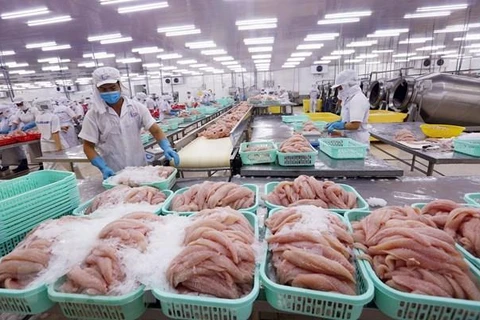Hanoi (VNA) – Sufficient material supply for processing plants is expected to help the seafood industry rake in 9 billion USD in export revenue in 2019, said the Ministry of Agriculture and Rural Development.
According to the ministry’s report, total seafood volume in the country was estimated at nearly 6.7 million tonnes during January-October, up 5.3 percent from the same time last year.
In the ten-month period, the country gained 7.06 billion USD from seafood export, accounting for 21.3 percent of the total export revenue of the agricultural sector.
Around 1.19 million tonnes of tra fish were cultivated during the period, up 8.6 percent from the same time last year. Meanwhile, the aquaculture production of brackish water shrimp, prawn, and white leg shrimp was 600,000 tonnes (up 4.4 percent), 251,160 tonnes (up 1.6 percent), 389,000 tonnes (up over 8 percent).
Other aquatic products were mollusc (220,000 tonnes), tilapia (150,000 tonnes), seaweed (100,000 tonnes), sea fish (40,000 tonnes) and cold water fish (2,000 tonnes)
Earlier, the Vietnam Association of Seafood Exporters and Producers (VASEP) said the country may not reach its target of 10 billion USD in aquatic exports due to a drop in prices, fluctuations in supply and demand, and trade barriers.
VASEP General Secretary Truong Dinh Hoe said the adjusted supply-demand balance in 2019 has pulled aquatic products’ prices down compared to previous years.
For example, tra fish prices in the US market in 2019 fell to 2 USD per kilo from 4-5 USD per kilo in 2018, he said.
Hoe said that a number of anti-dumping lawsuits against Vietnam in the US, the main market for Vietnamese aquatic products, were also among the factors leading to the drop in revenue.
Meanwhile, the Chinese market has seen a strong shift to official trade, resulting in changes in demand for aquatic products, thus affecting Vietnam’s shipments to the market.
At the same time, fierce competition from Indian and Indonesian shrimp exporters has caused difficulties for Vietnam as shrimp is the biggest currency earner of the country’s aquatic sector.
Export revenue from shrimp, one of the three major products of the sector besides tra fish and seafood, has suffered a sharp drop in 2019 to only 3.4 billion USD, far below the target of 4.2 billion USD.
However, Hoe said that when the EU-Vietnam Free Trade Agreement becomes effective in 2020, Vietnamese shrimp will see a brighter future in the European market. He advised domestic exporters to be well prepared to take advantage of the deal.
In the US market, anti-dumping issues are forecast to remain the major problem along with competition in price from India.
At the same time, trading methods in the Chinese market may be changed, thus Vietnamese firms should be prepared for the adjustment, said Hoe.
He noted that export revenue of tra fish is expected to stay stable at over 2 billion USD, which is short of the target of 2.4 billion USD for the whole year, while seafood is forecast to reach a record 3.6 billion USD.
Hoe also predicted that a target of 10 billion USD in aquatic export revenue is feasible for 2020. He said that shrimp prices in 2020 will face fewer difficulties from competition.
VASEP has also forecast that tra fish exports to the EU will increase by 20-35 percent in 2019.
Last year, tra fish exports to the EU bounced back after declining from 2010 to 2017.
From January 1 to May 15 this year, tra fish exports to the EU reached 105.2 million USD, up 31.5 percent against the same period of 2018.
The growth was largely attributed to four markets, namely the Netherlands, the UK, Germany and Belgium.
From the beginning of the year to mid-May, tra fish exports to the Netherlands rose by 12.2 percent, the UK 59.4 percent, Germany 61.6 percent and Belgium 63.8 percent.
In the period, tra fish was listed among the most popular white fish in Europe, making up 9 percent of the region’s white fish market. Each year, the EU consumes nearly 3 million tonnes of white fish, 89 percent of which is imported.
In the near future, with tax advantages from the EU-Vietnam Free Trade Agreement (EVFTA), tra fish exports to the EU are expected to see positive growth.
Demand for tra fish imports from central and eastern European countries is also increasing. A large proportion of tra fish imported by the Netherlands and Germany has been shipped to central and eastern European nations which do not have big import ports.
Tra fish products labeled by the Aquaculture Stewardship Council (ASC) are likely to be favoured in the European market.
To secure a firm foothold in the market, the tra fish sector needs to strengthen the management and control of food quality and safety, experts suggested./.

























